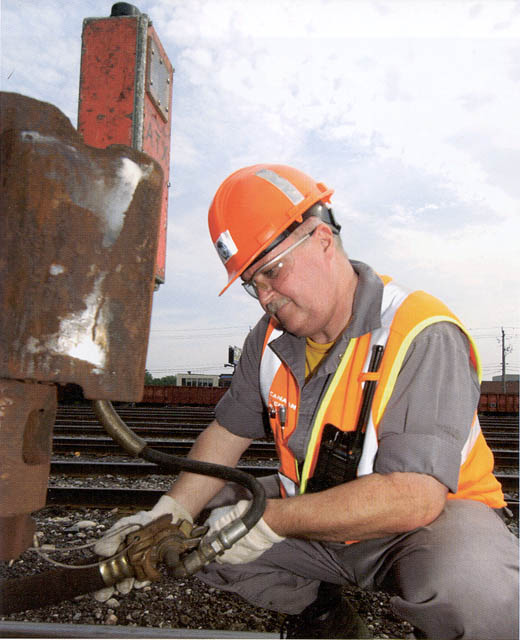 |
Summer 2006
|
Car Inspectors Practice the Ritual of "Line, Lock, and
Display"

Car inspector Tom Rowe
connects a Sense and Braking Unit (SBU) to the air brake line.
Among the most visible members of
the mechanical services team are the car inspectors stationed at CPR yards from coast to coast. Momentum recently
visited one of them to observe the safety-critical role they play.
"We're part of a system of check and double check", says Tom Rowe, a car inspector at Lambton Yard in West
Toronto and a 28-year CPR veteran. "Every time a train arrives or departs a yard, a car inspector
checks each car on those trains. We work like a relay team, passing the inspected trains from yard to yard and
checking each time to make sure no defects have occurred while the cars have been moving over the road or while
they've been processed within the yard".
Tom stows a Sense and Braking Unit (SBU) into his pick up truck and we head to the tail end of a road switcher as it
comes to a halt on the departure track. First order of business is the safety ritual known as "line, lock, and
display".
Tom notes, "Before you do anything, you line or position the track switch behind the train you're going to
inspect in order to divert other trains away from it. You lock that switch to assure that. And then you display a
blue flag by day or blue light by night to warn other employees you're at work and this train is not to be moved or
coupled to. Only then is it safe to install the SBU, inspect the train, and perform the brake test.
The SBU - the end-of-train device with the flashing red light - will transmit to the crew in the
locomotive's cab the air brake line pressure at the tail end and the train's forward or reverse motion. In case of an
emergency brake application, the SBU will also instantaneously "dump" the air from the tail end at the same
time that it's being exhausted by the locomotive, making for safer and faster applications of the brakes throughout
the train's length. Tom locks the SBU on to the last coupler on the last car and connects it to the train's air brake
line.
After he isolates the last car's air brake system from the rest of the train, Tom radios the engineer, "Okay on
this end for the emergency brake test, CP 8222".
Tom watches and listens for signs the brakes have been fully applied. Next order of business is to slowly walk the 31
car lengths of the train, scanning for:
- Un-released hand brakes;
- Sticking or loose brake shoes;
- Damaged couplers, air hoses, and brake gear;
- Excessive wear on the flanges and treads of the wheels;
- Bent or broken safety appliances, such as ladders and grab irons;
- Loose or missing strapping and other load blocking devices;
- Shifted loads, and;
- Anything else that could in any way cause damage to the equipment, the track, wayside signals and structures,
or injure employees and the public.
Now satisfied that all is in good mechanical order, Tom radios the conductor, "Okay, CP 8222, all clear from the
car department. Highball. Have safe trip.
As the train heads on to the main line, Tom clears the departure track by retrieving the blue flag and he points out,
"Safety and vigilance", Tom says. "You've got the programmed maintenance inspections of the equipment
in the shops, the scanning by the hot box and dragging equipment detectors on the main lines, the inspections the
crews give each other's trains out on the road and, of course, the car inspectors watching everything as it departs
or enters the yards. Like I said, check and double check".
This Canadian Pacific Spanner article
is copyright 2006 by the Canadian Pacific Railway and is reprinted here with their
permission. All photographs, logos, and trademarks are the property of the Canadian Pacific Railway
Company.
|